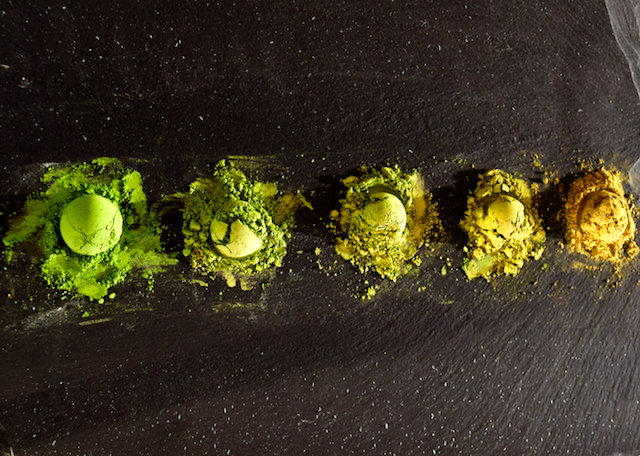
Confused whether you should buy matcha that's ceremonial vs. culinary, yellow or green, cheap or expensive?
Here's some information to help you determine whether the matcha you're buying is high-quality or low-quality based on some simple key identifiers, and the implications it has on nutritional content.
It's important to remember that matcha comes from the same plant as most other teas including black, oolong, white and green teas all come from. The leaves of this tea plant called camellia sinensis are hand-picked, steamed, dried and then ground into the powder we call "matcha."
Several weeks prior to harvesting the tea leaves, the tea plants are covered in nets to block direct sunlight. This slows the growth of the leaves, stimulating chlorophyll production, which in turn darkens the leaves which encourages the production of L-theanine, among other amino acids.
Like many shrubs or plants, the tea plant will bud several times during the growing season and the leaves are subsequently harvested several times during a growing season to make matcha.
The finest matcha is produced from the leaves picked during the very first harvest of the season. First-harvest matcha is the matcha of choice due to the fact that the tea plants have been in hibernation all winter and grow more slowly than the leaves picked later in the season. Because of this, first-harvest matcha leaves contain significantly more chlorophyll and more importantly, the amino acids (including L-theanine).
The more chlorophyll the matcha contains, the more vibrant green the powder. And the more L-theanine the matcha contains, the sweeter the taste.
The tea leaves picked during subsequent harvests contain less chlorophyll and amino acids, giving these lower grades of matcha a bolder, more vegetal taste and a lighter green and often times a yellow/brown appearance.
When it comes to matcha, assessing the color plays an important part in determining the quality level.
Yellow matcha: If your matcha has a yellowish or brownish hue, this typically means that mature leaves (less optimal) were used to make your matcha, and the more bitter and astringent it will taste. It also signifies that this matcha contains less amino acids, specifically L-theanine. L-theanine is what provides the feeling of calm alertness we get when we consume matcha. Because of its bitter taste, we recommend that you don't drink this matcha with water, but rather use it in something where it's bitterness will be masked by other flavors.
Yellow/Green matcha: If you're matcha is green with a yellow tint, it probably means that most of the leaves came from mostly the 2nd harvest, and there was a mix of optimal and mature leaves used to create this matcha. This grade is normally called "culinary grade" because the matcha is still slightly bitter to consume. It's recommended to use this in smoothies or as an ingredient in recipes. Some matcha companies pass their 2nd harvest grades off as premium "Ceremonial" grades so just beware of this. Our Jade Grade uses leaves from 1st and 2nd harvest and is therefore best for mixing into a smoothie or recipe.
Bright Green matcha: Bright green matcha means that the leaves were picked during the 1st harvest and are younger, more premium, and have a high concentration of both chloryphyll and L-theanine. If the matcha is vibrant green, this typically indicates high-quality, ceremonial grade. Our Hikari and Emerald grades are ceremonial, while our Kiwami grade is super ceremonial. You can typically associate the greener the matcha with a smoother, slightly sweet taste. If you're preparing matcha with water or a splash of milk, it's recommended that you use higher grade matcha to enjoy a smooth, slightly sweet taste.
Please send us any additional questions you have on this topic to hello@matchaful.com
[Updated 2019-06-13]
